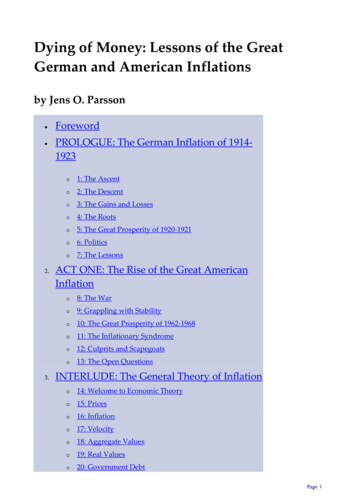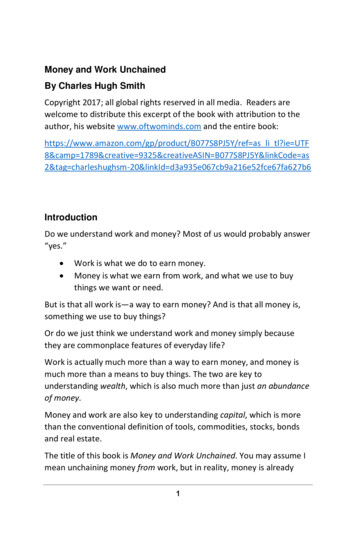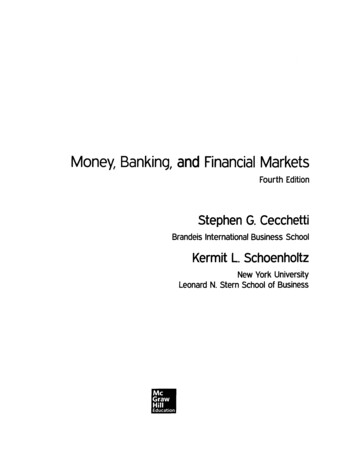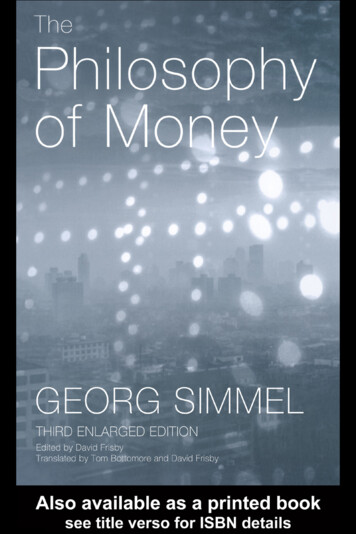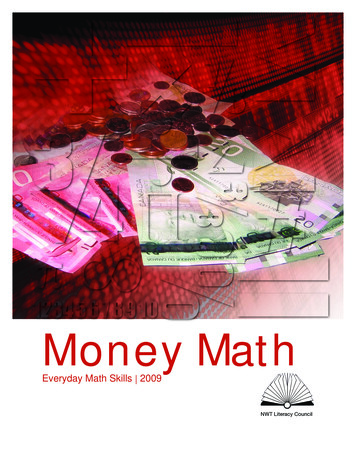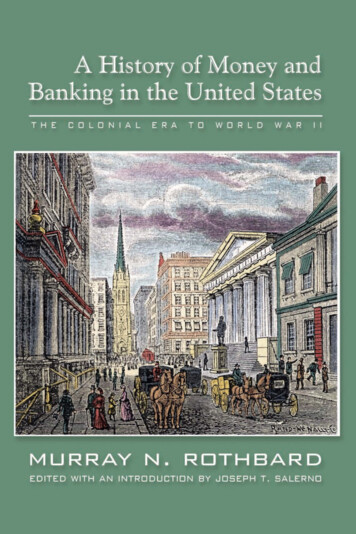
Transcription
A HISTORY OF MONEY AND BANKINGIN THE UNITED STATES:THE COLONIAL ERA TO WORLD WAR II
The Ludwig von Mises Institute dedicates this volumeto all of its generous donors and wishes to thankthese Patrons, in particular:George W. Connell[James L. Bailey, James Bailey Foundation;Robert Blumen; Christopher P. Condon;John William Galbraith; Hugh E. Ledbetter;Frederick L. Maier; Mr. and Mrs. R. Nelson Nash[Richard Bleiberg; John Hamilton Bolstad;Mr. and Mrs. J.R. Bost; Mr. and Mrs. Willard Fischer;Douglas E. French; Albert L. Hillman, Jr.; L. Charles Hilton, Jr.;Mr. and Mrs. Truman Johnson; Neil Kaethler;Robert Kealiher; Dr. Preston W. Keith; David Kramer;Mr. and Mrs. William W. Massey, Jr.; Hall McAdams;Dr. Dorothy Donnelley Moller; Francis Powers, M.D.;Donald Mosby Rembert; James M. Rodney;Joseph P. Schirrick; James Whitaker, M.D.[J. Terry Anderson, Anderson Chemical Company;Mr. and Mrs. Ross K. Anderson; Toby O. Baxendale; Robert Bero;Dr. V.S. Boddicker; Dr. John Brätland; John Cooke;Carl Creager; Capt. and Mrs. Maino des Granges;Clyde Evans, Evans Cabinet Corporation;Elton B. Fox, The Fox Foundation; James W. Frevert; Larry R. Gies;Frank W. Heemstra; Donald L. Ifland; Dr. and Mrs. John W. Johnson;Richard J. Kossmann, M.D.; Alfonso Landa; John Leger;Arthur L. Loeb; Ronald Mandle;Ellice McDonald, Jr., CBE, and Rosa Hayward McDonald, CBE;Norbert McLuckie; In honor of Mikaelah S. Medrano;Joseph Edward Paul Melville;Dr. and Mrs. Donald Miller; Reed W. Mower;Terence Murphree, United Steel Structures; James O’Neill;Victor Pankey; Catherine Dixon Roland; John Salvador;Conrad Schneiker; Mark M. Scott;Robert W. Smiley, Jr., Benefit Capital Companies;Jack DeBar Smith; Val L. Tennent; David W. Tice;Lawrence Van Someren, Sr.; Dr. Jim Walker;Mr. and Mrs. Quinten E. Ward; Dr. Thomas L. Wenck;Keith S. Wood; Steven Lee Yamshon; Jeannette Zummo
A HISTORY OF MONEY AND BANKINGIN THE UNITED STATES:THE COLONIAL ERA TO WORLD WAR IIMURRAY N. ROTHBARD
Cover art: Wall Street, 1886. Permission for use of this print is granted to theLudwig von Mises Institute by Old World Prints, Ltd.Copyright 2002 by the Ludwig von Mises InstituteAll rights reserved. Written permission must be secured from the publisherto use or reproduce any part of this book, except for brief quotations in critical reviews or articles. For information, write the Ludwig von MisesInstitute, 518 West Magnolia Avenue, Auburn, Alabama 36849-5301;www.mises.org.ISBN: 0-945466-33-1
CONTENTSIntroduction.7Joseph T. SalernoPART 1The History of Money and BankingBefore the Twentieth Century . . . . . . . . . . . . . . . . . . . . . . . 45PART 2The Origins of the Federal Reserve . . . . . . . . . . . . . . . . . . . . . 179PART 3From Hoover to Roosevelt:The Federal Reserve and the Financial Elites . . . . . . . . . . 259PART 4The Gold-Exchange Standardin the Interwar Years . . . . . . . . . . . . . . . . . . . . . . . . . . . . . . 347PART 5The New Deal and theInternational Money System . . . . . . . . . . . . . . . . . . . . . . . . 431Index. . . . . . . . . . . . . . . . . . . . . . . . . . . . . . . . . . . . . . . . . . . . . 4915
INTRODUCTIONIn this volume, Murray Rothbard has given us a comprehensive history of money and banking in the United States, fromcolonial times to World War II, the first to explicitly use theinterpretive framework of Austrian monetary theory. But evenaside from the explicitly Austrian theoretical framework undergirding the historical narrative, this book does not “look” or“feel” like standard economic histories as they have been written during the past quarter of a century, under the influence ofthe positivistic “new economic history” or “cliometrics.” Thefocus of this latter approach to economic history, which todaycompletely dominates this field of inquiry, is on the applicationof high-powered statistical methods to the analysis of quantitative economic data. What profoundly distinguishes Rothbard’sapproach from the prevailing approach is his insistence upontreating economic quantities and processes as unique and complex historical events. Thus, he employs the laws of economictheory in conjunction with other relevant disciplines to traceeach event back to the nonquantifiable values and goals of theparticular actors involved. In Rothbard’s view, economic lawscan be relied upon in interpreting these nonrepeatable historical events because the validity of these laws—or, better yet,their truth—can be established with certainty by praxeology, ascience based on the universal experience of human action thatis logically anterior to the experience of particular historical7
8A History of Money and Banking in the United States:The Colonial Era to World War IIepisodes.1 It is in this sense that it can be said that economictheory is an a priori science.In sharp contrast, the new economic historians view historyas a laboratory in which economic theory is continually beingtested. The economic quantities observed at different dates inhistory are treated like the homogeneous empirical data generated by a controlled and repeatable experiment. As such, theyare used as evidence in statistical tests of hypotheses regardingthe causes of a class of events, such as inflations or financialcrises, that are observed to recur in history. The hypothesis thatbest fits the evidence is then tentatively accepted as providing avalid causal explanation of the class of events in question, pending future testing against new evidence that is constantlyemerging out of the unfolding historical process.One of the pioneers of the new economic history, Douglass C.North, a Nobel Prize-winner in economics, describes its methodin the following terms:It is impossible to analyze and explain the issues dealt within economic history without developing initial hypothesesand testing them in the light of available evidence. The initial hypotheses come from the body of economic theory thathas evolved in the past 200 years and is being continuallytested and refined by empirical inquiry. The statistics provide the precise measurement and empirical evidence bywhich to test the theory. The limits of inquiry are dictated by theexistence of appropriate theory and evidence. . . . The evidence is,ideally, statistical data that precisely define and measure theissues to be tested.21Forgood discussions of praxeology, see Ludwig von Mises, HumanAction: A Treatise on Economics, Scholar’s Edition (Auburn, Ala.: MisesInstitute, 1998), pp. 1–71; Murray N. Rothbard, The Logic of Action I:Method, Money, and the Austrian School (Cheltenham, U.K.: Edward Elgar,1997), pp. 28–77; and Hans-Hermann Hoppe, Economic Science and theAustrian Method (Auburn, Ala.: Mises Institute, 1995).2Douglass C. North, Growth and Welfare in the American Past: ANew Economic History (Englewood Cliffs, N.J.: Prentice-Hall, 1966),pp. 1–2 (emphasis in original).
Introduction9This endeavor of North and others to deliberately extendthe positivist program to economic history immediately confronts two problems. First, as North emphasizes, this approachnarrowly limits the kinds of questions that can be investigatedin economic history. Those issues which do not readily lendthemselves to formulation in quantitative terms or for whichstatistical data are not available tend to be downplayed or neglected altogether. Thus the new economic historians are morelikely to seek answers to questions like: What was the net contribution of the railroad to the growth of real GNP in the UnitedStates? Or, what has been the effect of the creation of the FederalReserve System on the stability of the price level and real output? They are much less likely to address in a meaningful waythe questions of what motivated the huge government landgrants for railroad rights-of-way or the passage of the FederalReserve Act.In general, the question of “Cui bono?”—or “Who benefits?”—from changes in policies and institutions receives verylittle attention in the cliometric literature, because the evidencethat one needs to answer it, bearing as it does on humanmotives, is essentially subjective and devoid of a measurable oreven quantifiable dimension. This is not to deny that new economic historians have sought to explain the ex post aggregatedistribution of income that results from a given change in theinstitutional framework or in the policy regime. What theirmethod precludes them from doing is identifying the ex antepurposes as well as ideas about the most efficacious means ofaccomplishing these purposes that motivated the specific individuals who lobbied for or initiated the change that effected anew income distribution. However, avoiding such questionsleaves the quantitative data themselves ultimately unexplained.The reason is that the institutions that contribute to their formation, such as the railroads or the Fed, are always the complexresultants of the purposive actions of particular individuals orgroups of individuals aimed at achieving definite goals by theuse of specific means. So the new economic history is not history in the traditional sense of an attempt to “understand” the
10A History of Money and Banking in the United States:The Colonial Era to World War IIhuman motives underlying the emergence of economic institutions and processes.The second and even more profound flaw in the new economic history is the relationship it posits between theory and history. For North, history is the source of the “empirical evidence”—that is, “ideally, statistical data”—against which theeconomic theory is tested. This means that the claim to validityof a particular theorem is always tentative and defeasible, resting as it does on its nonfalsification in previous empirical tests.However, this also means that economic history must be continually revised, because the very theory which is employed toidentify the causal relations between historical events canalways be falsified by new evidence coming to light in the ongoing historical process. In other words, what the new economichistorians characterize as “the intimate relationship betweenmeasurement and theory” is in reality the vicious circle thatensnares all attempts to invoke positivist precepts in the interpretation of history.3 For if the theory used to interpret pastevents can always be invalidated by future events, then it isunclear whether theory is the explanans or the explanand in historical research.Rothbard’s approach to monetary history does not focus onmeasurement but on motives. Once the goals of the actors andtheir ideas about the appropriate means for achieving thesegoals have been established, economic theory, along with othersciences, is brought to bear to trace out the effects of theseactions in producing the complex events and processes of historywhich are only partially and imperfectly captured in statisticaldata. This is not to say that Rothbard ignores the quantitativeaspects of historical monetary processes. Indeed, his bookabounds with money, price, and output data; but these data are3RobertWilliam Fogel, “The New Economic History: Its Findingsand Methods,” in The Reinterpretation of American History, Robert WilliamFogel and Stanley L. Engerman, eds. (New York: Harper and Row, 1971),p. 7.
Introduction11always interpreted in terms of the motivations of those whohave contributed to their formation. For Rothbard, a particularprice datum is, no less than the Spanish-American War, a historical event, and its causes must be traced back to the subjectiveaims governing human plans and choices.In flatly rejecting the positivist approach to economic history,Rothbard adopts the method of historical research first formulated by Ludwig von Mises. In developing this method, Misescorrectly delineated, for the first time, the relationship betweentheory and history. It is Rothbard’s great contribution in this volume—and his earlier America’s Great Depression—to be the firstto consistently apply it to economic history.4 It is worth summarizing this method here for several reasons. First, Mises’s writings on the proper method of historical research have inexplicably been almost completely ignored up to the present, even bythose who have adopted Mises’s praxeological approach in economics.5 Second, familiarity with Mises’s method of historicalresearch illuminates the source and character of the remarkabledistinctiveness of Rothbard’s historical writings. In particular, itserves to correct the common but mistaken impression thatRothbard’s historical writings, especially on the origin anddevelopment of the U.S. monetary system, are grounded innothing more substantial than an idiosyncratic “conspiracy theory of history.” Third, it gives us an opportunity to elucidate theimportant elaboration of Mises’s method that Rothbard contributed and which he deploys to great effect in explicating thetopic of this volume. And finally, we find in Mises’s method a4Murray N. Rothbard, America’s Great Depression, 5th ed. (Auburn,Ala.: Mises Institute, 2000).5As Rothbard has written of Theory and History, the book in whichMises gives this method its most detailed exposition, this work “hasmade remarkably little impact, and has rarely been cited even by theyoung economists of the recent Austrian revival. It remains by far themost neglected masterwork of Mises.” Murray N. Rothbard, Preface toLudwig von Mises’s Theory and History: An Interpretation of Social andEconomic Evolution, 2nd ed. (Auburn, Ala.: Mises Institute, 1985), p. xi.
12A History of Money and Banking in the United States:The Colonial Era to World War IIdefinitive refutation of the positivist’s claim that it is impossibleto acquire real knowledge of subjective phenomena like humanmotives and that, therefore, economic history must deal exclusively with observable and measurable phenomena.To begin with, Mises grounds his discussion of historicalmethod on the insight that ideas are the primordial stuff of history. In his words:History is the record of human action. Human action is theconscious effort of man to substitute more satisfactoryconditions for less satisfactory ones. Ideas determine whatare to be considered more and less satisfactory conditionsand what means are to be resorted to to alter them. Thusideas are the main theme of the study of history.6This is not to say that all history should be intellectual history,but that ideas are the ultimate cause of all social phenomena,including and especially economic phenomena. As Mises puts it,The genuine history of mankind is the history of ideas. It isideas that distinguish man from all other beings. Ideasengender social institutions, political changes, technological methods of production, and all that is called economicconditions.7Thus, for Mises, historyestablishes the fact that men, inspired by definite ideas,made definite judgments of value, chose definite ends, andresorted to definite means in order to attain the ends chosen,and it deals furthermore with the outcome of their actions,the state of affairs the action brought about.8Ideas—specifically those embodying the purposes andvalues that direct action—are not only the point of contact6Ibid.,pp. 224–25.p. 187.8Ludwig von Mises, The Ultimate Foundation of Economic Science: AnEssay on Method, 2nd ed. (Kansas City, Mo.: Sheed Andrews and McMeel,1978), p. 45.7Ibid.,
Introduction13between history and economics, but differing attitudes towardthem are precisely what distinguish the methods of the two disciplines. Both economics and history deal with individualchoices of ends and the judgments of value underlying them.On the one hand, economic theory as a branch of praxeologytakes these value judgments and choices as given data andrestricts itself to logically inferring from them the laws governing the valuing and pricing of the means or “goods.” As such,economics does not inquire into the individual’s motivations invaluing and choosing specific ends. Hence, contrary to the positivist method, the truth of economic theorems is substantiatedapart from and without reference to specific and concrete historical experience. They are the conclusions of logically validdeduction from universal experience of the fact that humansadopt means that they believe to be appropriate in attainingends that they judge to be valuable.9The subject of history, on the other hand, “is action and thejudgments of value directing action toward definite ends.”10This means that for history, in contrast to economics, actionsand value judgments are not ultimate “givens” but, in Mises’swords, “are the starting point of a specific mode of reflection, ofthe specific understanding of the historical sciences of humanaction.” Equipped with the method of “specific understanding,” the historian, “when faced with a value judgment and theresulting action . . . may try to understand how they originatedin the mind of the actor.”119Itis true that in deriving theorems that apply to the specific conditions characterizing human action in our world, a few additional facts ofa lesser degree of generality are inserted into the deductive chain of reasoning. These include the facts that there exists a variety of naturalresources, that human labor is differentiated, and that leisure is valued asa consumer’s good. See Mises, Human Action; Rothbard, The Logic ofAction I; and Hoppe, Economic Science and the Austrian Method.10Mises, Theory and History, p. 298.11Ibid., p. 310.
14A History of Money and Banking in the United States:The Colonial Era to World War IIThe difference between the methods of economics and history may be illustrated with the following example. The economist qua economist “explains” the Vietnam War-era inflationthat began in the mid-1960s and culminated in the inflationaryrecession of 1973–1975 by identifying those actions of the Fedwith respect to the money supply that initiated and sustainedit.12 The historian, including the economic historian, however,must identify and then assign weights to all those factors thatmotivated the various members of the Fed’s Board of Governors(or of the Federal Open Market Committee) to adopt this courseof action. These factors include: ideology; partisan politics;pressure exerted by the incumbent administration; the grasp ofeconomic theory; the expressed and perceived desires of theFed’s constituencies, including commercial bankers and bonddealers; the informal power and influence of the Fed chairmanwithin the structure of governance; and so on.In short, the economic historian must supply the motivesunderlying the actions that are relevant to explaining the historical event. And for this task, his only suitable tool is understanding. Thus, as Mises puts it,The scope of understanding is the mental grasp of phenomena which cannot be totally elucidated by logic, mathematics, praxeology, and the natural sciences to the extent thatthey cannot be cleared up by all these sciences.13To say that a full explanation of any historical event, including an economic one, requires that the method of specificunderstanding be applied is not to diminish the importance ofpure economic theory in the study of history. Indeed, as Misespoints out, economics12Someeconomists would date this inflation from 1965 to 1979, butthe precise dates do not matter for our present purposes. See, for example, Thomas Mayer, Monetary Policy and the Great Inflation in the UnitedStates: The Federal Reserve and the Failure of Macroeconomic Policy(Northampton, Mass.: Edward Elgar, 1999).13Mises, Human Action, p. 50.
Introduction15provides in its field a consummate interpretation of pastevents recorded and a consummate anticipation of theeffects to be expected from future actions of a definite kind.Neither this interpretation nor this anticipation tells anything about the actual content and quality of the actual individuals’ judgments of value. Both presuppose that the individuals are valuing and acting, but their theorems areindependent of and unaffected by the particular characteristics of this valuing and acting.14For Mises, then, if the historian is to present a completeexplanation of a particular event, he must bring to bear not onlyhis “specific understanding” of the motives of action but thetheorems of economic science as well as those of the other“aprioristic,” or nonexperimental, sciences, such as logic andmathematics. He must also utilize knowledge yielded by thenatural sciences, including the applied sciences of technologyand therapeutics.15 Familiarity with the teachings of all thesedisciplines is required in order to correctly identify the causalrelevance of a particular action to a historical event, to trace outits specific consequences, and to evaluate its success from thepoint of view of the actor’s goals.For example, without knowledge of the economic theoremthat, ceteris paribus, changes in the supply of money causeinverse changes in its purchasing power, a historian of the priceinflation of the Vietnam War-era probably would ignore the Fedand its motives altogether. Perhaps, he is under the influence ofthe erroneous Galbraithian doctrine of administered prices withits implication of cost-push inflation.16 In this case, he mightconcentrate exclusively and irrelevantly on the motives ofunion leaders in demanding large wage increases and on theobjectives of the “technostructure” of large business firms in14Mises,Theory and History, p. 309.p. 301.16John Kenneth Galbraith, The New Industrial State (New York: NewAmerican Library, 1967), pp. 189–207, 256–70.15Ibid.,
16A History of Money and Banking in the United States:The Colonial Era to World War IIacceding to these demands and deciding what part of the costincrease to pass on to consumers. Thus, according to Mises,If what these disciplines [i.e., the aprioristic and the naturalsciences] teach is insufficient or if the historian chooses anerroneous theory out of several conflicting theories held bythe specialists, his effort is misled and his performance isabortive.17But what exactly is the historical method of specific understanding, and how can it provide true knowledge of a whollysubjective and unobservable phenomenon like human motivation? First of all, as Mises emphasizes, the specific understandingof past events isnot a mental process exclusively resorted to by historians. Itis applied by everybody in daily intercourse with all his fellows. It is a technique employed in all interhuman relations.It is practiced by children in the nursery and kindergarten, bybusinessmen in trade, by politicians and statesmen in affairsof state. All are eager to get information about other people’svaluations and plans and to appraise them correctly.18The reason this technique is so ubiquitously employed bypeople in their daily affairs is because all action aims at rearranging future conditions so that they are more satisfactoryfrom the actor’s point of view. However, the future situationthat actually emerges always depends partly on the purposesand choices of others besides the actor. In order to achieve hisends, then, the actor must anticipate not only changes affectingthe future state of affairs caused by natural phenomena, butalso the changes that result from the conduct of others who,like him, are contemporaneously planning and acting.1917Mises,Theory and History, p. 301.p. 265.19As Mises puts it, “Understanding aims at anticipating future conditions as far as they depend on human ideas, valuations, and actions.”Mises, Ultimate Foundation, p. 49.18Ibid.,
Introduction17Understanding the values and goals of others is thus aninescapable prerequisite for successful action.Now, the method that provides the individual planningaction with information about the values and goals of otheractors is essentially the same method employed by the historianwho seeks knowledge of the values and goals of actors inbygone epochs. Mises emphasizes the universal application ofthis method by referring to the actor and the historian as “thehistorian of the future” and “the historian of the past,” respectively.20 Regardless of the purpose for which it is used, therefore,understandingaims at establishing the facts that men attach a definitemeaning to the state of their environment, that they valuethis state and, motivated by these judgments of value, resortto definite means in order to preserve or to attain a definitestate of affairs different from that which would prevail ifthey abstained from any purposeful reaction. Understanding deals with judgments of value, with the choice of endsand of the means resorted to for the attainment of theseends, and with the valuation of the outcome of actions performed.21Furthermore, whether directed toward planning action orinterpreting history, the exercise of specific understanding isnot an arbitrary or haphazard enterprise peculiar to each individual historian or actor; it is the product of a discipline thatMises calls “thymology,” which encompasses “knowledge ofhuman valuations and volitions.”22 Mises characterizes thisdiscipline as follows:Thymology is on the one hand an offshoot of introspectionand on the other a precipitate of historical experience. It iswhat everybody learns from intercourse with his fellows. It20Mises,Theory and History, p. 320.Ultimate Foundation, p. 48.22Mises, Theory and History, p. 265.21Mises,
18A History of Money and Banking in the United States:The Colonial Era to World War IIis what a man knows about the way in which people valuedifferent conditions, about their wishes and desires andtheir plans to realize these wishes and desires. It is theknowledge of the social environment in which a man livesand acts or, with historians, of a foreign milieu about whichhe has learned by studying special sources.23Thus, Mises tells us, thymology can be classified as “a branchof history” since “[i]t derives its knowledge from historicalexperience.”24 Consequently, the epistemic product of thymological experience is categorically different from the knowledgederived from experiments in the natural sciences. Experimentalknowledge consists of “scientific facts” whose truth is independent of time. Thymological knowledge is confined to “historical facts,” which are unique and nonrepeatable events.Accordingly, Mises concludes,All that thymology can tell us is that in the past definite menor groups of men were valuing and acting in a definite way.Whether they will in the future value and act in the sameway remains uncertain. All that can be asserted about theirfuture conduct is speculative anticipation of the future basedon specific understanding of the historical branches of thesciences of human action. . . . What thymology achieves isthe elaboration of a catalogue of human traits. It can moreover establish the fact that certain traits appeared in the pastas a rule in connection with certain other traits.25More concretely, all our anticipations about how family members, friends, acquaintances, and strangers will react in particular situations are based on our accumulated thymological experience. That a spouse will appreciate a specific type of jewelryfor her birthday, that a friend will enthusiastically endorse ourplan to see a Clint Eastwood movie, that a particular studentwill complain about his grade—all these expectations are23Ibid.,p. 266.p. 272.25Ibid., pp. 272, 274.24Ibid.,
Introduction19based on our direct experience of their past modes of valuingand acting. Even our expectations of how strangers will react indefinite situations or what course political, social, and economicevents will take are based on thymology. For example, ourreservoir of thymological experience provides us with theknowledge that men are jealous of their wives. Thus, it allowsus to “understand” and forecast that if a man makes overtadvances to a married woman in the presence of her husband,he will almost certainly be rebuffed and runs a considerable riskof being punched in the nose. Moreover, we may forecast witha high degree of certitude that both the Republican and theDemocratic nominees will outpoll the Libertarian Party candidate in a forthcoming presidential election; that the price forcommercial time during the televising of the Major League Soccer championship will not exceed the price for commercialsduring the broadcast of the Super Bowl next year; that the average price of a personal computer will be neither 1 million nor 10 in three months; and that the author of this paper will neverbe crowned king of England. All of these forecasts, and literallymillions of others of a similar degree of certainty, are based onthe specific understanding of the values and goals motivatingmillions of nameless actors.As noted, the source of thymological experience is our interactions with and observations of other people. It isacquired either directly from observing our fellow men andtransacting business with them or indirectly from readingand from hearsay, as well as out of our special experienceacquired in previous contacts with the individuals or groupsconcerned.26Such mundane experience is accessible to all who havereached the age of reason and forms the bedrock foundationfor forecasting the future conduct of others whose actions willaffect their plans. Furthermore, as Mises points out, the use ofthymological knowledge in everyday affairs is straightforward:26Ibid.,p. 313.
20A History of Money and Banking in the United States:The Colonial Era to World War IIThymology tells no more than that man is driven by variousinnate instincts, various passions, and various ideas. Theanticipating individual tries to set aside those factors thatmanifestly do not play any concrete role in the concrete caseunder consideration. Then he chooses among the remainingones.27To aid in this task of narrowing down the goals and desiresthat are likely to motivate the behavior of particular individuals, we resort to the “thymological concept” of “human character.”28 The concrete content of the “charact
issues to be tested.2 8 A History of Money and Banking in the United States: The Colonial Era to World War II 1For good discussions of praxeology, see Ludwig von Mises, Human Action: A Treatise on Economics, Scholar’s Edition (Auburn, Ala.: Mises Institute, 19
